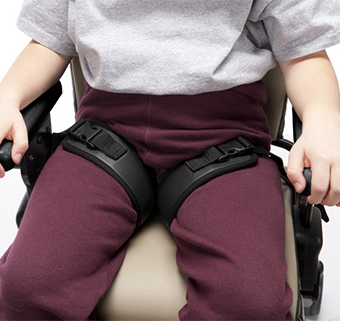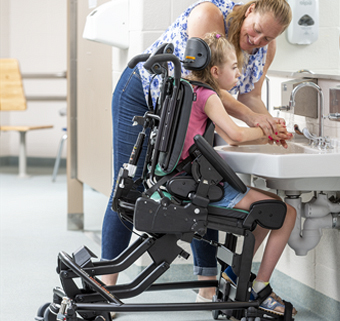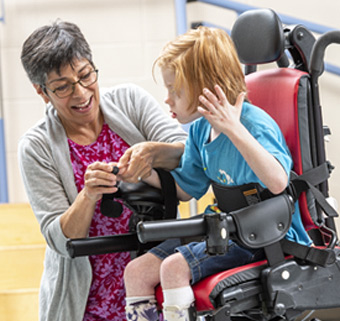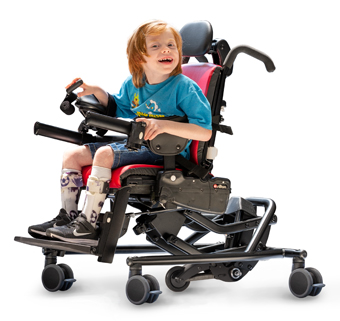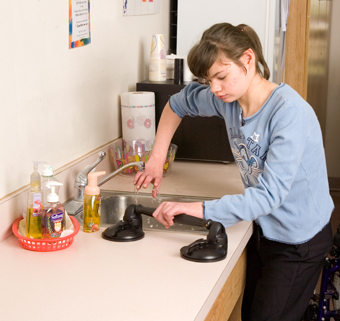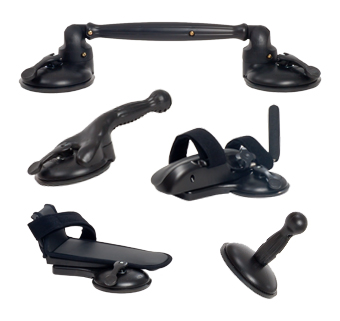Positioning for Functional Seating
| May 2020 Sitting is a position necessary for daily activities. During the day we sit to eat, work or relax. Sitting functionally for these various activities seems simple but is complex under the surface, involving interaction of postural and trunk muscles. This is important for a therapist to understand when instructing children with disabilities who spend much of their day in a seated position. The differences in passive and active sitting postures affect the overall function of children with disabilities.
Sitting is a position necessary for daily activities. During the day we sit to eat, work or relax. Sitting functionally for these various activities seems simple but is complex under the surface, involving interaction of postural and trunk muscles. This is important for a therapist to understand when instructing children with disabilities who spend much of their day in a seated position. The differences in passive and active sitting postures affect the overall function of children with disabilities.
Passive Sitting and Health Considerations
Sitting in a resting position is called passive sitting. When relaxing in a reclined position such as one provided by a sun porch lounge or a comfy living room couch, the upper body and head are leaning back and the feet are supported. In this posture, muscles are at rest and gravity relaxes the body into the seat. For children with significant physical disabilities who spend long hours in a wheelchair or stroller, prolonged passive sitting can cause problems. In the reclined position, children have little opportunity for independent movement because they don’t have the strength to overcome gravity. As a result, a child may sit with their head tilted back or flopped forward. This does not necessarily mean they are tired or bored; on the contrary, it may result from low muscle tone and the need for better positioning.
Prolonged passive positioning contributes to several issues, including decreased eye contact and social interaction – imagine staring at the floor or ceiling all day. Additionally, the head-down position results in rounded back and shoulders, limiting lung expansion and making breathing and speaking difficult.1 Eating and swallowing ability is also adversely affected by poor trunk and head positioning.1 Moreover, flexion contractures can emerge over time due to prolonged sitting, and lack of physical activity and adequate time in an upright posture.
Many wheelchairs and strollers place children in a passive sitting position, which may be necessary for transport. It is vital, however, to recognize the disadvantages of prolonged time spent in these devices. A child will frequently slide forward with their pelvis in a sacral sitting position, even after just thirty minutes in a wheelchair.2 Another drawback of most wheelchairs is that they are not functional for daily activities.3 They are difficult to maneuver around the home to access a sink for hand-washing or tooth-brushing, and to bring to a table for family meals or companionship during homework time. The seat is too high for fun times on the carpet with family or pets. Being at eye level with peers is essential for social development and psychological well-being.4
Step-by-Step Active Sitting for Function
A child’s long-term health and social future can be fortified by opportunities for active sitting; adaptive seating equipment can change the picture. It is widely recognized that guided postural positioning in an adaptive chair produces outstanding outcomes for function and health. Your physical therapist, occupational therapist, or speech therapist are best equipped to provide this advice on a personal level, but here are some basic positioning tips.
- Adjust the seat depth to fully support the underside of the child’s thighs, leaving space of about an inch behind the knees to avoid rubbing.
- Place the child’s hips (pelvis) in a slightly forward-angled (anteriorly tilted) position and use a seatbelt or pelvic harness to secure the hips in place at the back of the chair seat.
- Encourage hip abduction with knees apart.5
- Provide support under the feet. When the feet are firmly planted, the body can be stabilized and balanced.6 Adjusting the height and angle of the footboard can make a difference in providing adequate foot contact.
- Placing the child’s forearms on a tray or table surface allows the arms to assist with weight-bearing and can establish better postural control of the upper body, neck and head.7, 8, 9
- Trial the position of the seat, experimenting between a horizontal and a slightly forward-tilted position of the seat surface. Observe your child’s head control and his/her ability to reach, and decide which seat angle position is best for the particular activity you are doing.
View this video for a demonstration of adjusting the Activity Chair for an active, functional sitting position:
Health Benefits of Active Sitting
Doing all of the above helps to provide a stable base of support that will promote better postural control of the trunk, arms and head.10, 11, 12 You will also see improvements in respiration; breathing and coughing will become easier.13, 14, 15 You may even notice increases in drooling and coughing up of mucous and fluids when a child is first placed in a functional, forward-leaning position, showing how this new posture assists clearing of the lungs. Start with short sessions and gradually increase time as the lungs begin to clear and the postural muscles become stronger.8
With an active sitting position, communication improves as well. Many children are non-verbal, and this active sitting aids their body language and facial expressions. For the child, a better visual field not only improves their quality of life but in some cases offers the possibility of improved eye-gaze communication.1 Because active sitting, through better alignment of the shoulders relative to the hips, promotes hand functionality, eye-hand coordination and activation of the postural muscles, it can also result in more effective use of communication devices.16
Good sitting posture and head alignment also improve eating and drinking significantly. Liquid and food can be retained in the mouth more effectively, and swallowing is easier. Children may even progress from bottle to cup drinking and from eating blended to chopped or cut-up food.17 Safe swallowing involves a certain pattern of closing the lips, the movement of the tongue, and closing of the airway as the food is moved from the mouth, down the throat to the stomach. A good head and trunk position can reduce the child’s risk of aspiration and related health issues such as pneumonia.
Postural control has a big influence on arm function.17, 18 In an adaptive chair, the angle of the seat itself can influence the use of the arms. It is best to assess each child individually to determine whether they do better with the seat surface flat or tilted slightly forward.20 In some cases, a forward tilt of the seat surface can improve the child’s arm movement control.21 For example, children with spastic hemiplegia (only one side is affected) demonstrate improved reaching ability when the seat is tilted forward. On the other hand, children with bilateral spastic CP (both legs affected) do better with the seat left horizontal.22, 23
Sit-to-Stand Transfers from the Active Sitting Position
The active, functional sitting position can be the first step toward sit-to-stand transfers. Intentionally positioning the chair seat higher and tilted forward helps the child move more easily from sitting to standing as they transfer out of the chair. Children who demonstrate the ability to perform this active sit-to-stand transfer will be more likely to be independent in walking one day. 24
Introducing Weight-Bearing in the Active Sitting Position
Children who have no weight-bearing ability through their legs can also be helped. Their feet should be firmly planted on the floor or footboard of the chair. The seat should be angled into a forward tilt, bringing the child’s center of gravity forward. The body will respond naturally by pressing down through the feet to move the hips and pelvis to the back of the chair seat and to straighten the spine.
Some children may only tolerate this position for short segments at first – perhaps only fifteen seconds. But with persistent practice, weight-bearing ability improves. A tray or table in front of the chair may help with the gradual introduction of weight-bearing as well. Place this surface close enough so the child can rest their arms on it to stabilize their trunk for an upright position. Because this position is secure, the butterfly harness or chest strap may be cautiously (temporarily) removed to allow the child to gain awareness of their body and their capabilities to actively engage their arms and core muscles to maintain this position. In time, improved head control emerges, and you will see your child holding this posture for longer periods.6
It is exciting to realize that through introducing active seating and postural changes, a child can become much more functional and active. It’s worth finding even one moment during a child’s day when you can give them this practice opportunity. Seeing the gradual gains your child will achieve over time will make the effort worth it.
References
- Fitzimmons, L. (2014). Positioning the Head: Strategies to Improve Head Control and Posture. NRRTS Directions, Vol 1., pp. 42-45. Retrieved on May 4, 2020 from https://cdn.rifton.com/-/media/files/rifton/product-brochures-and-additional-info/head-control-article-from-directions-publication.pdf?la=en
- Lacoste M, Therrien M, Prince F. (2009) Stability of children with cerebral palsy in their wheelchair seating: perceptions of parents and therapists. Disabil Rehabil Assist Technol. 4(3):143-50. Abstract: https://www.tandfonline.com/doi/full/10.1080/17483100802362036
- Stober, C. (2011, Aug 3.) Seating Problems Solved by the Rifton Activity Chair. Rifton Adaptive Mobility and Positioning Blog. Retrieved May 4, 2020 from https://www.rifton.com/adaptive-mobility-blog/blog-posts/2011/august/seating-problems-solved-by-the-rifton-activity-chair
- Oxender, T. (2015, Jan 26.) Benefits of Adaptive Seating Beyond the Wheelchair. Rifton Adaptive Mobility and Positioning Blog. Retrieved May 4, 2020 from https://www.rifton.com/adaptive-mobility-blog/blog-posts/2015/january/active-sitting-wheelchair
- Child Development and Rehabilitation. http://www.childdevelopment.ca/Home.aspx 2014 GMFCS Hip Health Clinical Tool [Positioning for Children GMFCS Levels IV-V: focus on hip health.] http://www.childdevelopment.ca/Libraries/Hip_Health/sunnyhill
- Noble, E. (2020, Jan 7.) Teaching Weight Acceptance with the Rifton Activity Chair. Rifton Adaptive Mobility and Positioning Blog. Retrieved May 4, 2020 from https://www.rifton.com/adaptive-mobility-blog/blog-posts/2020/january/teaching-weight-acceptance-with-rifton-activity-chair
- Stavness, C. (2006). The effect of positioning for children with cerebral palsy on upper-extremity function: A review of the evidence. Physical and Occupational Therapy in Pediatrics. 26(3):39–53. Abstract: https://www.tandfonline.com/doi/abs/10.1080/J006v26n03_04
- Thomson, G. (2016, Feb 29.) Adaptive Equipment for Classrooms. Rifton Adaptive Mobility and Positioning Blog. Retrieved May 4, 2020 from https://www.rifton.com/adaptive-mobility-blog/blog-posts/2016/february/adaptive-equipment-for-classrooms-principles-part-1
- Noble, E. (2015, Jan 19.) Teaching Active Sitting Skills. Rifton Adaptive Mobility and Positioning Blog. Retrieved May 4, 2020 from https://www.rifton.com/adaptive-mobility-blog/blog-posts/2015/january/active-sitting-move-forearm-prompts
- Harris SR, and Roxborough L. (2005) Efficacy and Effectiveness of Physical Therapy in Enhancing Postural Control in Children With Cerebral Palsy. Neural Plast 12(2-3): 229–243. Free Full Text https://www.ncbi.nlm.nih.gov/pmc/articles/PMC2565452/pdf/NP-12-229.pdf
- Costigan FA, Light J.(2011) Functional seating for school-age children with cerebral palsy: an evidence-based tutorial. Lang Speech Hear Serv Sch. Apr;42(2):223-36. Abstract https://lshss.pubs.asha.org/article.aspx?articleid=1777038 [Full Text Available on PTNow]
- Angsupaisal M, Maathuis CG, Hadders-Algra M. (2015) Adaptive seating systems in children with severe cerebral palsy across International Classification of Functioning, Disability and Health for Children and Youth version domains: a systematic review. Dev Med Child Neurol. 57(10):919-30. Free Full Text https://onlinelibrary.wiley.com/doi/full/10.1111/dmcn.12762
- Shin HK, Byeon EJ, Kim SH (2015) Effects of seat surface inclination on respiration and speech production in children with spastic cerebral palsy. J Physiol Anthropol. 34(1):1-6. Free Full Text https://www.ncbi.nlm.nih.gov/pmc/articles/PMC4424889/
- Redstone, F. (2004). The effect of seating position on respiratory patterns of preschoolers with cerebral palsy. International Journal of Rehabilitation Research. 27(4):283–288. Abstract https://www.ncbi.nlm.nih.gov/pubmed/15572991
- Redstone F. (2005). Seating position and length of utterance of preschoolers with cerebral palsy. Perceptual and Motor Skills. 101(3):961–962. Abstract https://www.ncbi.nlm.nih.gov/pubmed/?term=16491702
- Costigan FA, Light J.(2010) Effect of seated position on upper-extremity access to augmentative communication for children with cerebral palsy: preliminary investigation. Am J Occup Ther. 64(4):596-604. Free Full Text https://ajot.aota.org/article.aspx?articleid=1854548
- Hulme JB, Shaver J, Acher S, Mullette L, Eggert C. (1987) Effects of adaptive seating devices on the eating and drinking of children with multiple handicaps. Am J Occup Ther. 41(2):81-9. Free Full Text https://ajot.aota.org/article.aspx?articleid=1882274
- Zulkapli NZ, Saat NZM, Kamaralzaman S. (2016) Postural Control Influence on Upper Extremity Function among Children with Cerebral Palsy: A Literature Review. Malaysian Journal of Health Sciences. (14)2:11-21. Abstract http://ejournal.ukm.my/jskm/article/view/14613
- Harbourne R, Kamm K. (2015). Upper extremity function: What’s posture got to do with it? Journal of Hand Therapy. 28(2):106-12. Abstract: https://www.jhandtherapy.org/article/S0894-1130(15)00026-5/fulltext [PDF available on PTNow]
- McNamara L, Casey J. (2007) Seat inclinations affect the function of children with cerebral palsy: a review of the effect of different seat inclines. Disabil Rehabil Assist Technol. 2(6):309-18. Abstract https://www.ncbi.nlm.nih.gov/pubmed/19263561
- Cherng, R, Lin, H, Ju, Y, Ho, C. (2009) Effect of seat surface inclination on postural stability and forward reaching efficiency in children with spastic cerebral palsy. Research in Developmental Disabilities. 30(6):1420-1427. Abstract: https://www.sciencedirect.com/science/article/pii/S0891422209001012?via%3Dihub
- Carlberg EB, Hadders-Algra M. (2005) Postural dysfunction in children with cerebral palsy: some implications for therapeutic guidance. Neural Plast. 12(2-3):221-8. Free Full Text https://www.ncbi.nlm.nih.gov/pmc/articles/PMC2565463/
- Hadders-Algra M, van der Heide JC, Fock JM, Stremmelaar E, van Eykern LA, Otten B.(2007) Effect of seat surface inclination on postural control during reaching in preterm children with cerebral palsy. Phys Ther. 87(7):861-71. Abstract https://academic.oup.com/ptj/article-abstract/87/7/861/2742167
- Begnoche DM, Chiarello LA, Palisano RJ, Gracely EJ, Westcott McCoy S, Orlin MN. (2016) Predictors of Independent Walking in Young Children with Cerebral Palsy. Physical Therapy. 96(2): 183-192. Free Full Text: https://academic.oup.com/ptj/article/96/2/183/2686378
